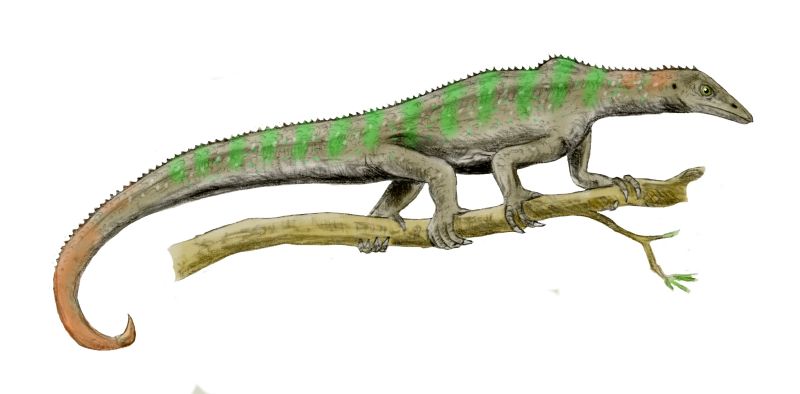- Drepanosauridae
Taxobox
name = Drepanosaurids
fossil_range =Late Triassic

image_width = 250px
image_caption = "Megalancosaurus "
regnum =Animal ia
phylum = Chordata
classis = Sauropsida
subclassis =Diapsid a
unranked_ordo =Avicephala
familia = Drepanosauridae
familia_authority = Pinna, 1979
subdivision_ranks = Genera
subdivision = "Dolabrosaurus " "Drepanosaurus " (type) "Hypuronector " "Megalancosaurus " "Vallesaurus "
synonyms = Megalancosauridae Renesto, 1994Drepanosauridae is a family of strange
reptile s that lived during the lateTriassic Period , 220 million years ago. The various species of drepanosaurid were characterized by odd specialized grasping limbs and often prehensile tails, adaptions for arboreal (tree-dwelling), and/or possibly aquatic lifestyles.Fossil s of drepanosaurids, also known as Simiosaurs ("monkey lizards"), have been found inNew Mexico ,New Jersey ,England , and northernItaly . The name Drepanosauridae is taken from the family's namesakegenus "Drepanosaurus ", which means "sickle lizard", a reference to their strongly curved claws.Description
Drepanosaurids are notable for their distinctive, triangular skulls, which resemble the skulls of
bird s. Some drepanosaurids, such as "Hypuronector ", had pointed, toothless, bird-likebeak s. This similarity to birds may have led to the possible mis-attribution of a drepanosaurid skull to the would-be "first bird", "Protoavis ".Renesto, S. (2000). "Bird-like head on a chameleon body: new specimens of the enigmatic diapsid reptile "Megalancosaurus" from the Late Triassic of northern Italy." "Rivista Italiana di Paleontologia e Stratigrafia", 106: 157–180. [http://users.unimi.it/rips/106/106N2.html Abstract] ]Drepanosaurids featured a suite of bizarre, almost
chameleon -like skeletal features. Above the shoulders of most species was a specialized "hump" formed from fusion of the vertebrae, possibly used for advanced muscle attachments to the neck, and allowing for quick forward-striking movement of the head (perhaps to catch insects). Many had derived hands with two fingers opposed to the remaining three, an adaptation for grasping branches. Some individuals of "Megalancosaurus " (possibly exclusive to either males or females) had a primate-like opposable toe on each foot, perhaps used by one sex for extra grip during mating. Most species had broad, prehensile tails, sometimes tipped with a large "claw", again to aid in climbing. These tails, tall and flat like those ofnewt s andcrocodile s, have led some researches to conclude that they were aquatic rather than arboreal. In 2004, Senter dismissed this idea, while Colbert and Olsen, in their description of "Hypuronector", state that while other drepanosaurs were probably arboreal, "Hypuronector" was uniquely adapted to aquatic life.Senter, P. (2004). "Phylogeny of Drepanosauridae (Reptilia: Diapsida)." "Journal of Systematic Palaeontology", 2(3): 257-268.] The tail of this genus was extremely deep and non-prehensile – much more fin-like than other drepanosaurids.Colbert, E. H., and Olsen, P. E. (2001). "A new and unusual aquatic reptile from the Lockatong Formation of New Jersey (Late Triassic, Newark Supergroup)." "American Museum Novitates", 3334: 1-24.]ystematics
Taxonomy
* Family Drepanosauridae
** Genus "Dolabrosaurus "
** Genus "Drepanosaurus "
** Genus "Hypuronector "
** Genus "Megalancosaurus "
** Genus "Vallesaurus "Phylogeny
Drepanosaurids have been difficult to pin down in terms of their
phylogenetic position. They have been assigned by some resarches to theprolacertiformes , though more recent studies place them together with the coelurosauravids and "Longisquama " in aclade called theAvicephala .Renesto, S. (1994). "Megalancosaurus", a possibly arboreal archosauromorph (Reptilia) from the Upper Triassic of northern Italy." "Journal of Vertebrate Paleontology", 14(1): 38-52.]Within Avicephala, Senter created the group Simiosauria to refer to all the species traditionally grouped together within the Drepanosauridae, reserving that name for a more exlusive sub-group. Senter found that "
Hypuronector ", originally described as a drepanosaurid, actually lies just outside that clade, along with the primitive drepanosaur "Vallesaurus ". He also recovered a close relationship between the drepanosaurs "Dolabrosaurus " and "Megalancosaurus ".The following
cladogram was found by Senter in his 2004 analysis.clade| style=font-size:100%;line-height:80%
label1=Simiosauria
1=clade
1="Vallesaurus "
label2=unnamed
2=clade
1="Hypuronector "
label2=Drepanosauridae
2=clade
1="Drepanosaurus "
label2= unnamed
2=clade
1="Dolabrosaurus "
2="Megalancosaurus "References
External links
* [http://www.hmnh.org/galleries/monkeylizards/ Monkey Lizards of the Triassic] - An illustrated article on drepanosaurs from HMNH.
* [http://dipbsf.uninsubria.it/paleo/drepanosaurus_unguicaudatus.htm Prof. Silvio Renesto—Vertebrate Paleontology at Insubria University: Research] - Images and discussion of "Drepanosaurus".
* [http://dipbsf.uninsubria.it/paleo/megalancosaurus1.htm Prof. Silvio Renesto—Vertebrate Paleontology at Insubria University: Research] - Images and discussion of "Megalancosaurus".
Wikimedia Foundation. 2010.
